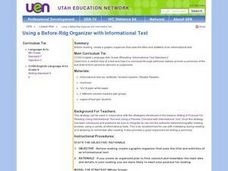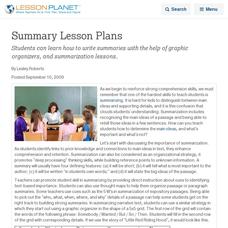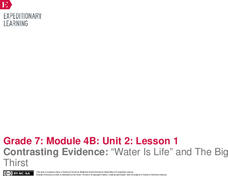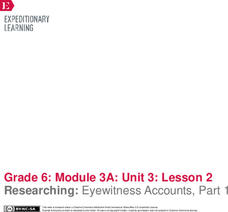Curated OER
Language Arts: Before-Reading Organizers
Sixth graders discover how to create graphic organizers using the titles and subtitles of informational texts. Following a teacher demonstration, they work in pairs to create their own organizers based on assigned texts. Upon...
Curated OER
Non-Fiction Read-aloud
Students listen to the reading of a book about the area of science they are currently studying.
Curated OER
Tooling Around Arizona: Reading Arizona Maps
Students study geography. In this Arizona maps lesson, students develop their map reading skills. They have class discussions and work independently with various copies of Arizona maps to practice those skills. This lesson mentions...
Curated OER
Reading for Righties and Lefties
Students choose novels to read in an open reading forum.
Curated OER
Cause and Effect: Expository Text
In this cause and effect worksheet, students read a reference article and complete a graphic organizer about the effects of Lincoln's elections. Article link is not given with worksheet.
Curated OER
Examine Persuasive Elements by Reading, Analyzing, and Discussing Persuasive Text
Students identify persuasive strategies and analyze arguments. In this persuasive writing lesson, students read "Chief Red Jacket's Reply" and "Reverend Cram's Speech to the Iroquois Nation" and chart major elements of each argument....
Curated OER
To Sum It All Up...
Learners one main goal when reading is to comprehend, and one strategy to improve reading comprehension is summarization. As students begin reading expository texts, it is vital for them to be able to pick out and summarize the main...
Curated OER
Outline and Shine
Seventh graders read and discuss a short story. They complete an outline of the story. They pair and share to evaluate each other's outlines.
Curated OER
Class President
Fourth graders develop vocabulary to aid in comprehension as they read the novel, Class President.
Curated OER
Learning About Hurricanes
Students write a research paper on hurricanes. In this weather lesson plan, students use a science text book to write down facts about hurricanes on note cards and then outline their essay. Students use the outline to create an organized...
Curated OER
To Entertain
Second graders consider the author's purpose for writing a text. In this author's purpose lesson, 2nd graders discuss reasons why author's write a book and how it can often be for entertainment. Students read a book, provide two examples...
Curated OER
Lesson 2: Distinguish Fact from Opinion in Books
An important part of reading informational text is being able to discern fact from opinion. The class reads chapter one from the book, Penguins by Lynn M. Stone. They analyze specific sections of the text to determine if what...
Curated OER
Parts of a Story
Students read a short fiction book and demostrate comprehension by identifying the main characters, setting, conflict, theme, and summarizing the main points. They organize the information in Inspiration and create a powerpoint to show...
Curated OER
Identifying the Solution in a Story
Using the book My Red Balloon by Eve Bunting, Kindergartners will gain an understanding that stories often have solutions. Using Eve Bunting's book as an example the teacher will identify the solution to the story and...
Curated OER
Reasonable Predictions
First graders discuss reasonable predictions for the outcome of stories. In this language arts lesson, 1st graders discuss that good readers predict what will happen next in a story. Students read the given text and make predictions...
Curated OER
Textual Analysis Lesson: Who Was Vermeer?
Apply the Textual Analysis process and answer questions about a text. Learners read Chasing Vermeer and "Who Was Vermeer?" They then use the textual analysis process to answer questions regarding what they read.
Curated OER
The Gift of the Magi Lesson Plan
Ninth graders read "The Gift of the Magi". While reading the story, they share their predictions about what they believe might happen next and the author's purpose of writing the story. To end the instructional activity, they work...
Curated OER
Major and Minor Characters
In this reading worksheet, students complete a chart about two characters from a book. Information includes the character names, how they look, how they act, how they interact with others, and how the student might relate to them.
Curated OER
Homes of the West
Fourth graders read about homes in Utah over time and design models of the homes. In this homes of the west lesson, 4th graders draw and label five homes that existed in the west. Students research each home and gather information...
Curated OER
Summary Lesson Plans
Students can learn how to write summaries with the help of graphic organizers, and summarization lessons.
Curated OER
Inspector Readers: The 002 Book Club
This unit introduces book clubs/literature circles to lower elementary classes, but could be adapted to higher grades. It outlines the anticipatory activity that includes a WebQuest, a discussion to clarify questions about the unit,...
Curated OER
Lesson Ideas for Comparing and Contrasting Content
Here are three lesson ideas to help students learn how to compare and contrast information in any content area
EngageNY
Contrasting Evidence: “Water Is Life” and The Big Thirst
Sometimes differing arguments support the same claim. Scholars complete a graphic organizer comparing how two authors support the claim that people need to better manage the world's water supply. Pupils also complete a graphic organizer...
EngageNY
Researching: Eyewitness Accounts, Part 1
Time to go on a quote hunt! Because learners cannot interview real eye witnesses for their newspaper articles, they read through text The Great Earthquake and Fires of 1906 looking for quotes to answer their questions. Learners...























